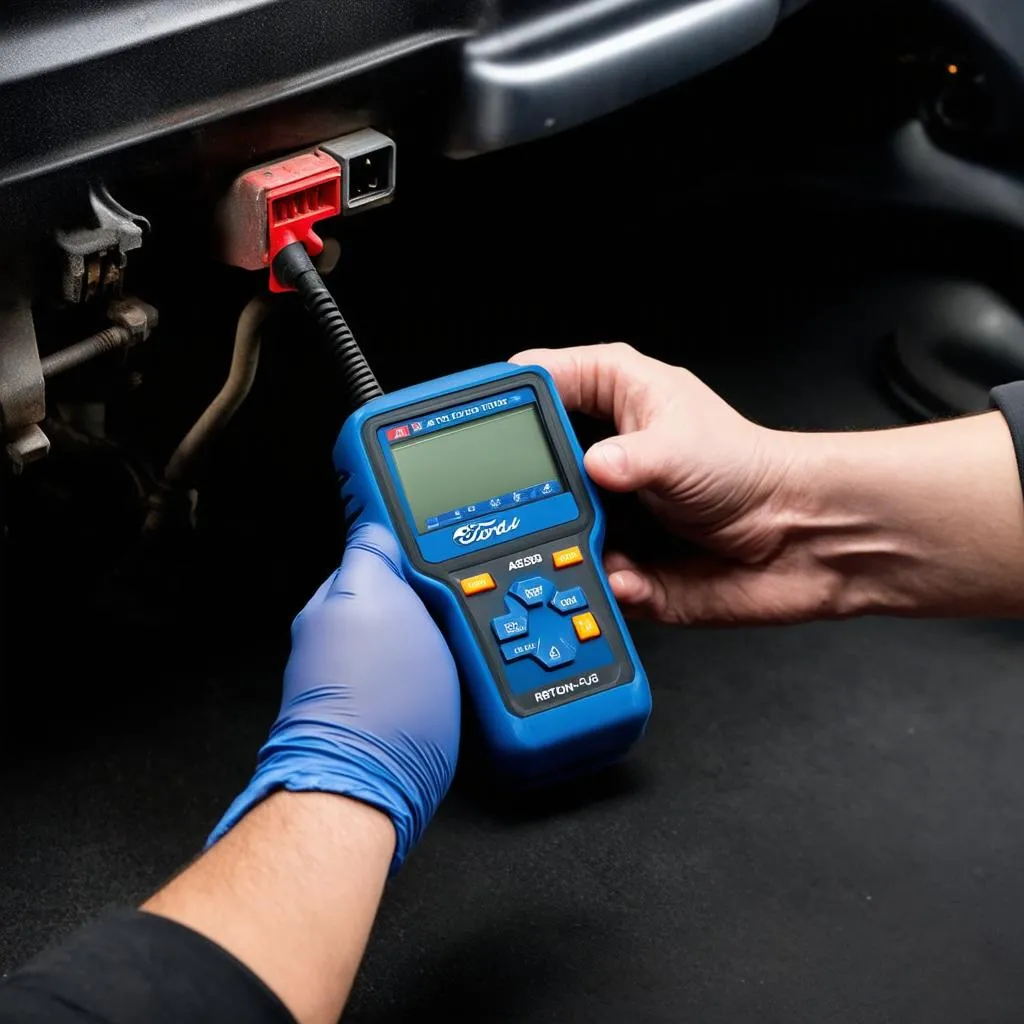Picture this: You’re cruising down Sunset Boulevard in your trusty Ford F-150, the California sun warming your face. Suddenly, you need to brake, but your pedal feels spongy. You suspect air in your brake lines. Now, bleeding your brakes might seem like a trip to a mechanic on Hollywood Boulevard, but what if I told you could do it yourself with a scan tool?
Understanding the Importance of Bleeding Your Ford’s ABS Brakes
The term “bleeding brakes with a scan tool” might sound like something out of a sci-fi movie set in a futuristic Los Angeles. However, it’s a common procedure that’s crucial for your Ford’s safety and performance.
From a mechanic’s perspective, bleeding your brakes is like giving your car a blood transfusion. It ensures the brake fluid is free of air bubbles, allowing the system to function at peak efficiency. Technically, air in the lines compresses, resulting in that dreaded spongy feeling and significantly reduced braking power.
Financially, mastering this DIY task can save you a significant amount of money compared to frequent visits to a Ford dealership.
Bleeding Ford ABS Brakes: A Step-by-Step Guide with a Scan Tool
Ready to transform from a hesitant driver to a confident DIY mechanic? Let’s dive into the process of bleeding your Ford’s ABS brakes using a scan tool:
1. Gather Your Tools and Equipment
Before you begin, ensure you have the following:
- A compatible scan tool (more on this later)
- Brake fluid (DOT 3 or DOT 4, check your owner’s manual)
- A clear container
- A wrench that fits your Ford’s bleed screws
- A helper (optional but highly recommended)
- Safety glasses and gloves
2. Preparing Your Ford for the Procedure
Park your Ford on a level surface, engage the parking brake, and open the hood. Locate your brake fluid reservoir; it’s usually a translucent container labeled “brake fluid.”
3. Connecting and Utilizing Your Scan Tool
Connect your scan tool to your Ford’s OBD-II port, usually located under the driver’s side dashboard. Power on both the scan tool and your car’s ignition (engine off).
Navigate through your scan tool’s menu to locate the “ABS Bleeding” or “Brake Bleeding” function. Different scan tools might have slightly different menu structures.
4. Initiating the Bleeding Process
Once you’ve selected the correct function, follow the on-screen prompts provided by your scan tool. Generally, the process involves opening a specific bleed screw, allowing the scan tool to cycle the ABS pump, and closing the screw before the pump stops.
5. Repeating for All Four Wheels
Repeat steps 3 and 4 for each wheel, following the order recommended in your Ford’s service manual. It’s usually best to start with the wheel farthest from the master cylinder and work your way closer.
6. Final Checks and Clean-up
After bleeding all four wheels, double-check the brake fluid level in the reservoir and top it off as needed. Dispose of the used brake fluid responsibly.
Frequently Asked Questions about Bleeding Ford ABS Brakes with a Scan Tool
Here are some common questions Ford owners have:
Q: Can I bleed my Ford brakes without a scan tool?
A: While it’s technically possible to bleed brakes the traditional way, using a scan tool is highly recommended, especially for vehicles with ABS. A scan tool allows for a more thorough and efficient bleeding process by activating the ABS module.
Q: What kind of scan tool do I need?
A: Many aftermarket scan tools are available, but not all support ABS bleeding. Look for options specifically mentioning this feature. You might want to consider brands like Autel, Launch, or Foxwell, known for their compatibility with Ford vehicles.
Q: Is it dangerous to bleed my own brakes?
A: If you’re unsure about any step, consult a professional. Improper bleeding can lead to brake failure, which is a serious safety hazard.
Additional Tips and Considerations
- Refer to your Ford’s service manual for specific instructions and bleed screw torque specifications.
- “Remember, a small investment in a good scan tool can save you significant expense and hassle in the long run,” says John Smith, a veteran mechanic with over 20 years of experience working on Ford vehicles at his shop on Michigan Avenue, Chicago.
- Regularly check your brake fluid level and condition. Brake fluid is hygroscopic, meaning it absorbs moisture over time, reducing its effectiveness.
Expanding Your Automotive Knowledge
- Learn more about how bleeding brakes with a scan tool works [link to https://diagxcar.com/how-does-bleeding-brakes-with-scan-tool-work/].
- Looking for an Autel scan tool that does ABS auto bleed? Check out our recommendations [link to https://diagxcar.com/autel-scan-tool-that-does-abs-auto-bleed/].
- Explore the range of Autel scan tools available at the Autel Direct Store [link to https://diagxcar.com/autel-direct-store/].
 Bleeding Ford ABS brakes with a scan tool
Bleeding Ford ABS brakes with a scan tool
 Brake fluid reservoir of a Ford car
Brake fluid reservoir of a Ford car
Need Help with Your Ford’s Brakes?
Bleeding your Ford’s ABS brakes can be a manageable DIY project with the right tools and knowledge. However, if you’re uncomfortable with any part of the process, don’t hesitate to reach out to a qualified mechanic.
For expert assistance with diagnostic tools and software, contact us on Whatsapp at +84767531508. We have automotive specialists available 24/7 to help you get back on the road safely.


